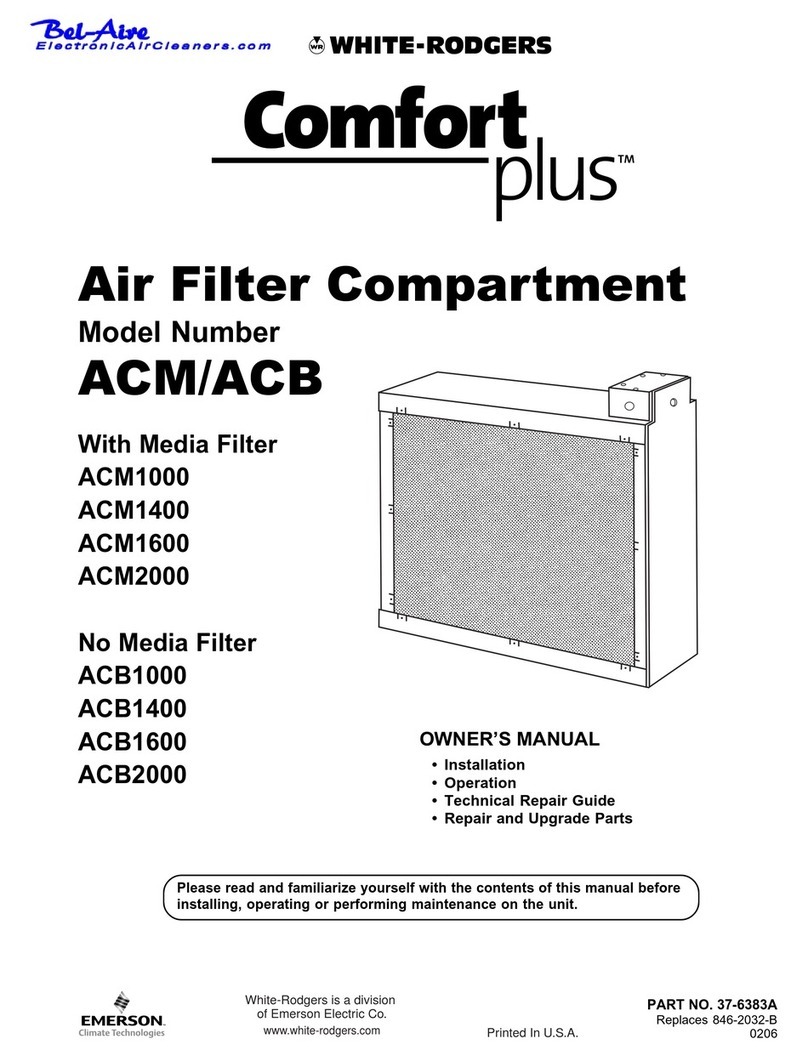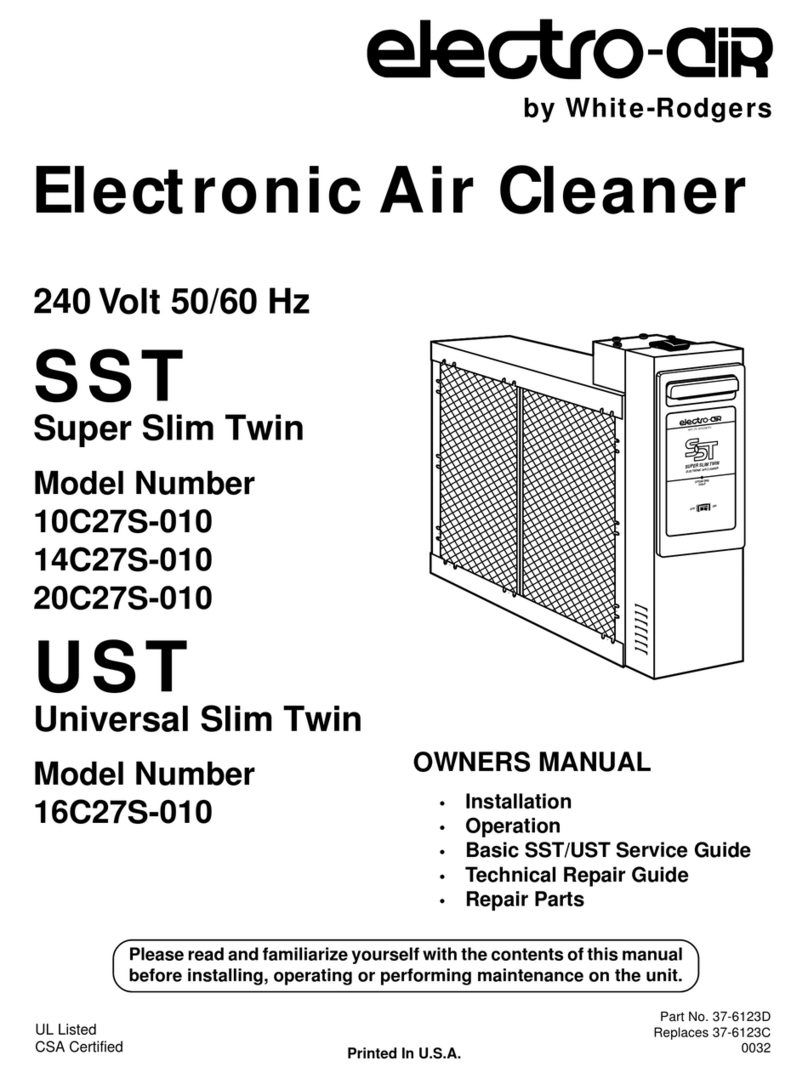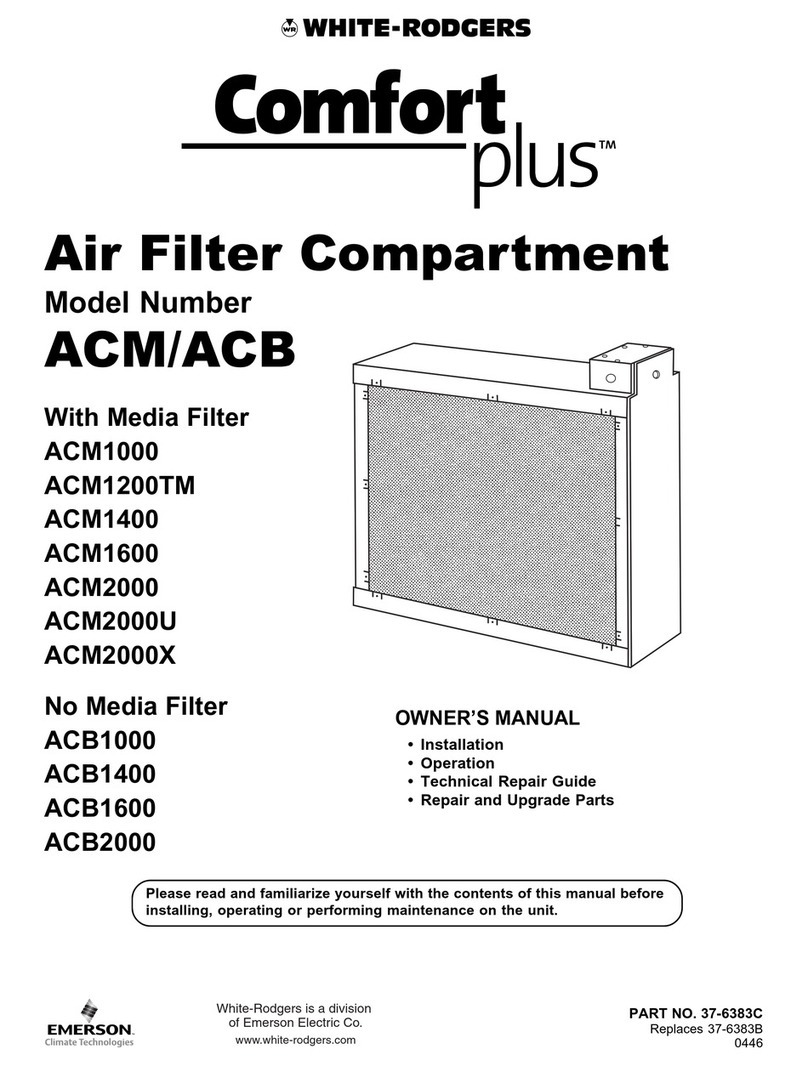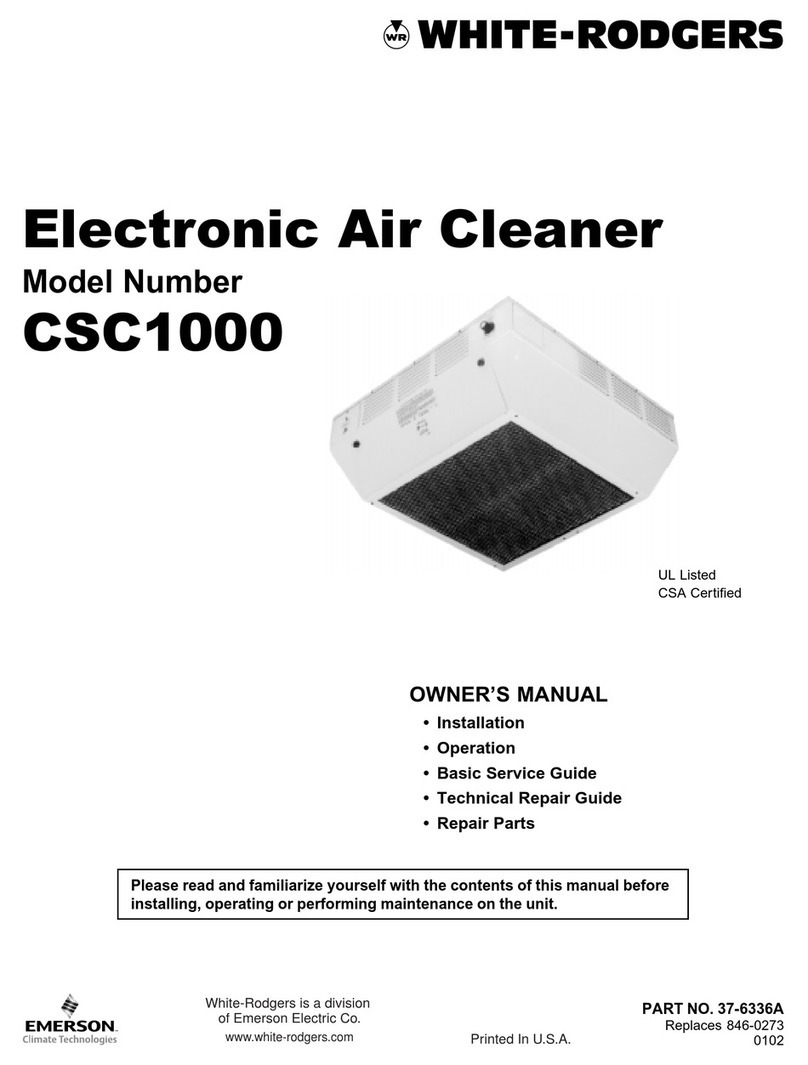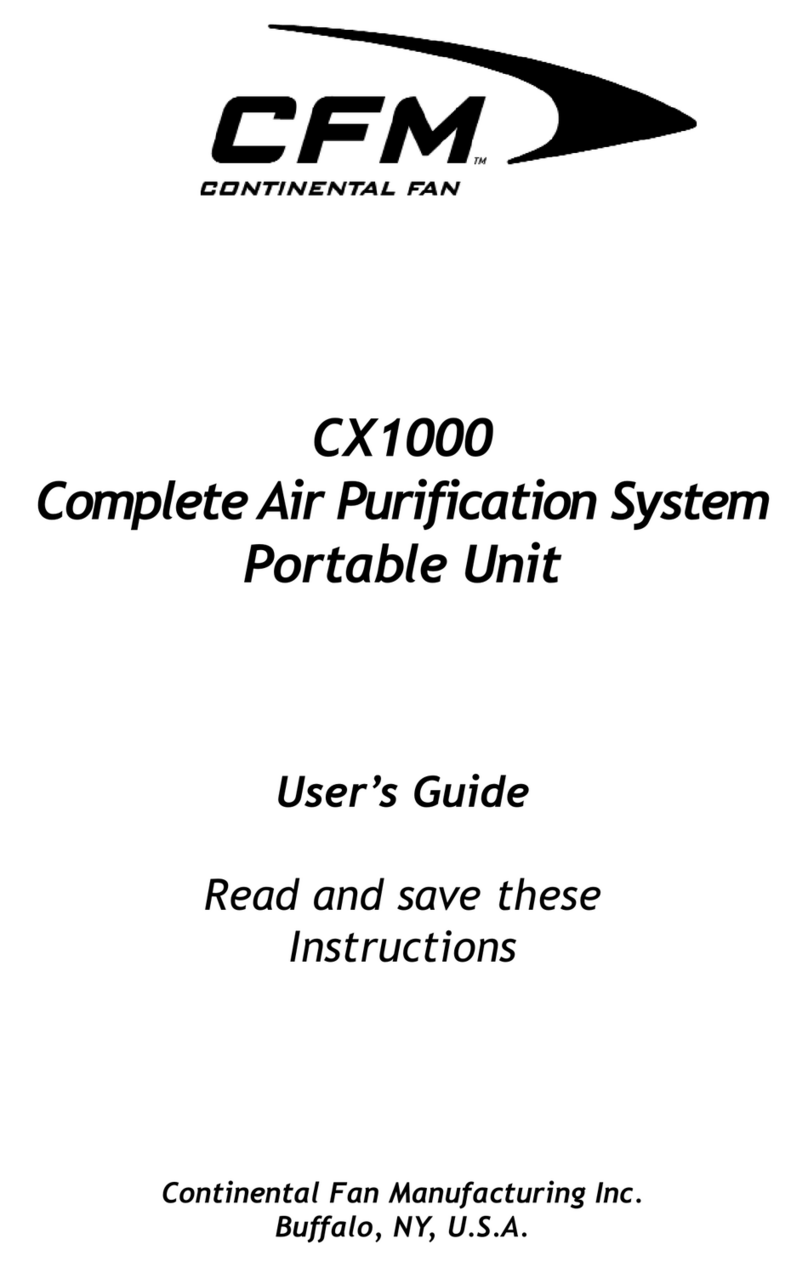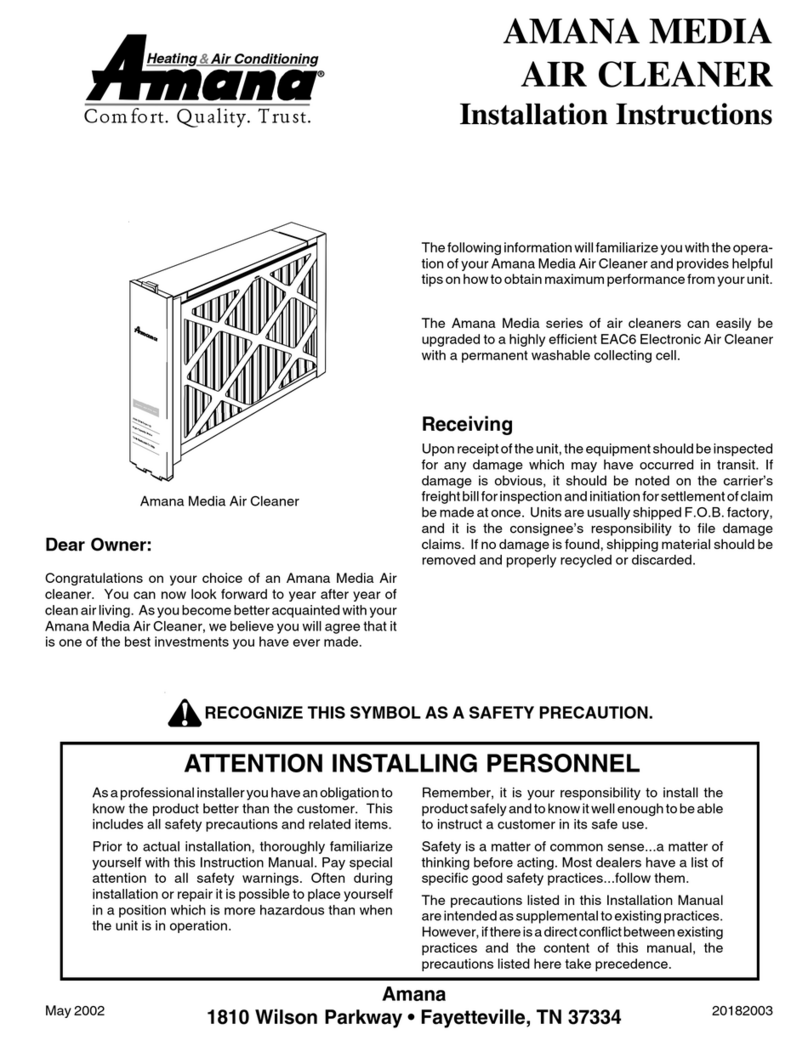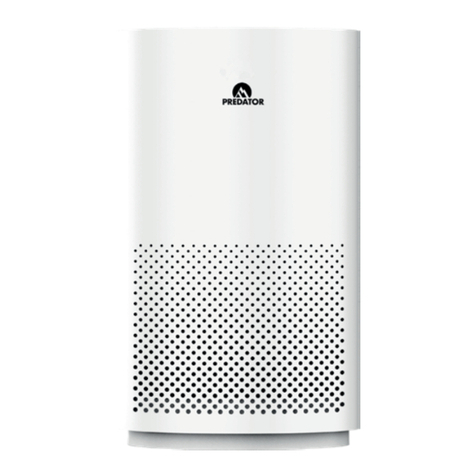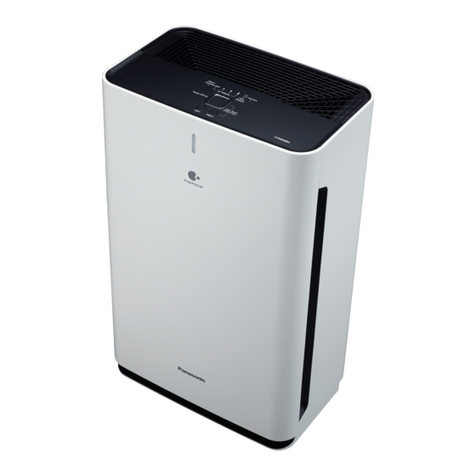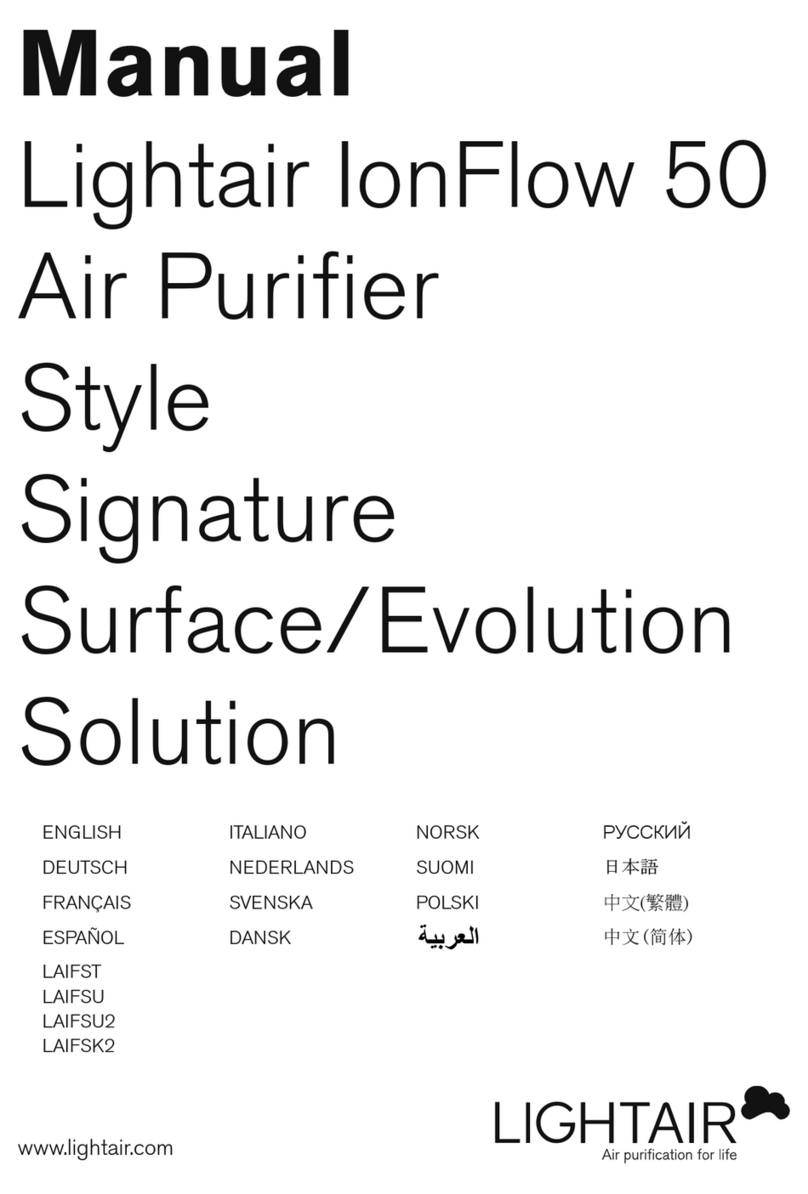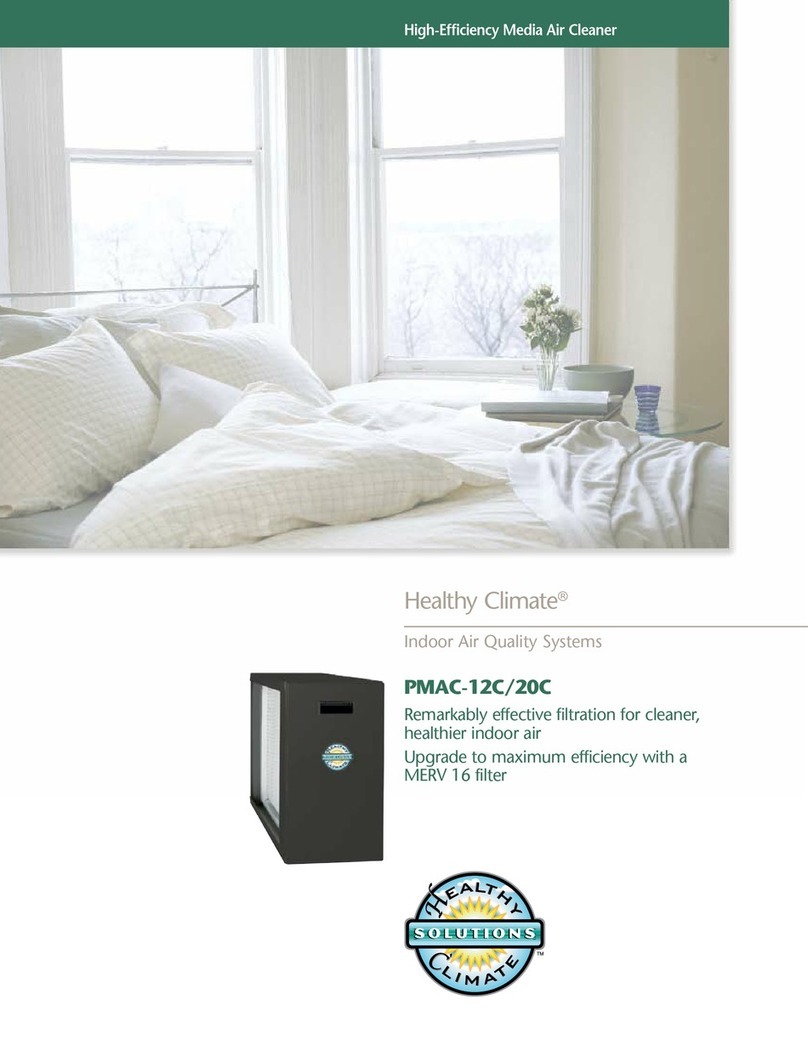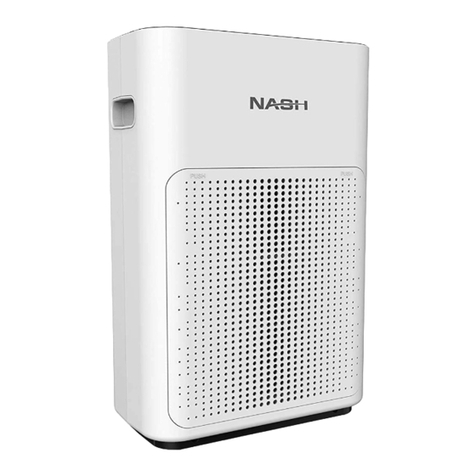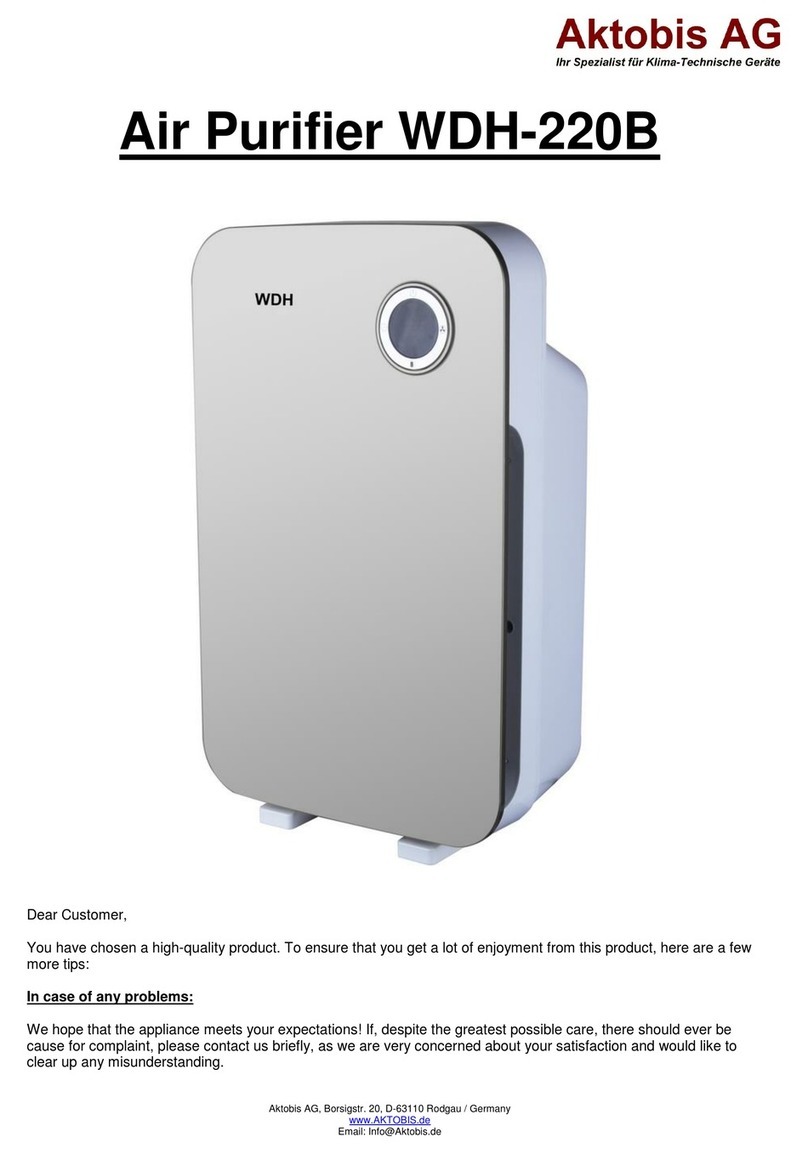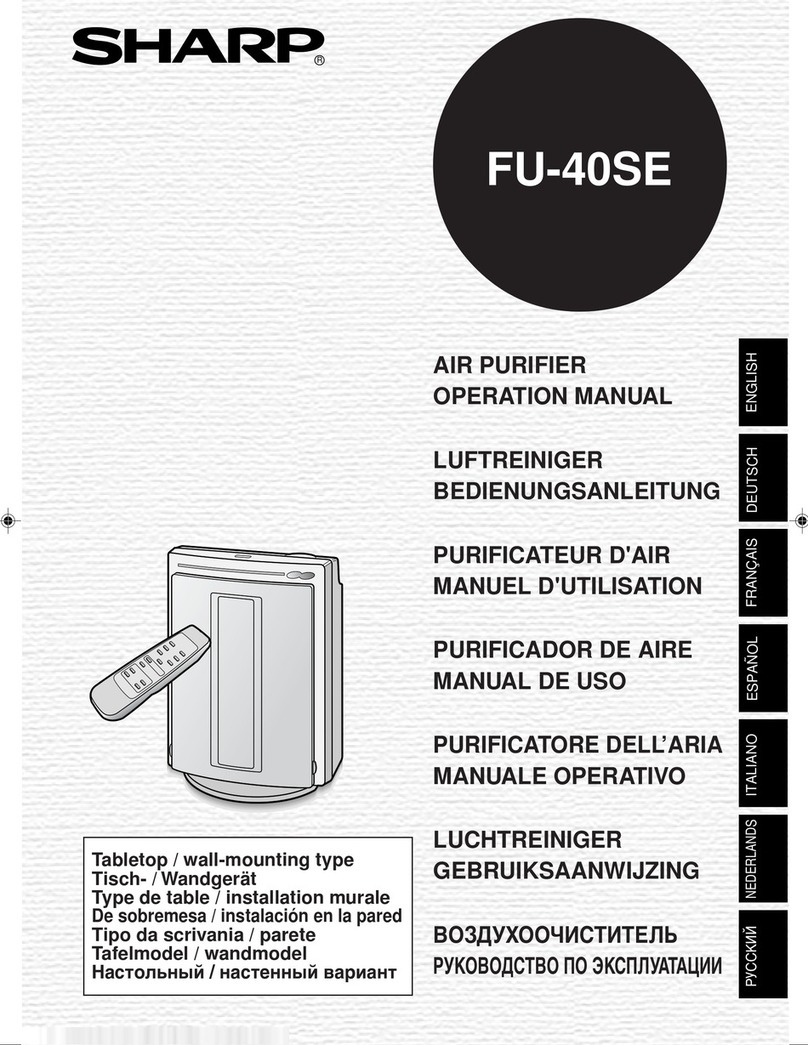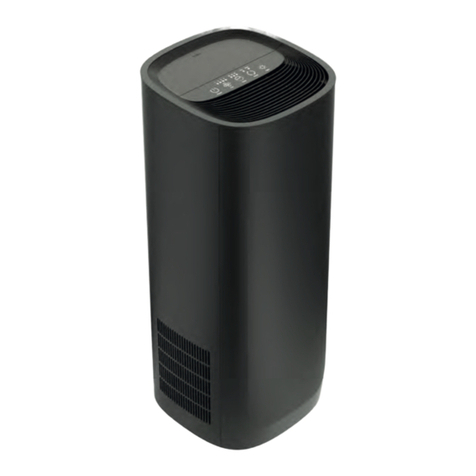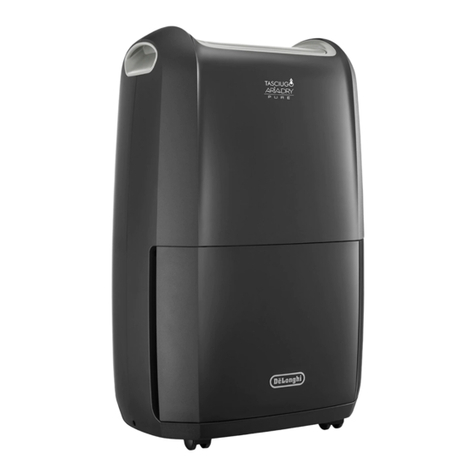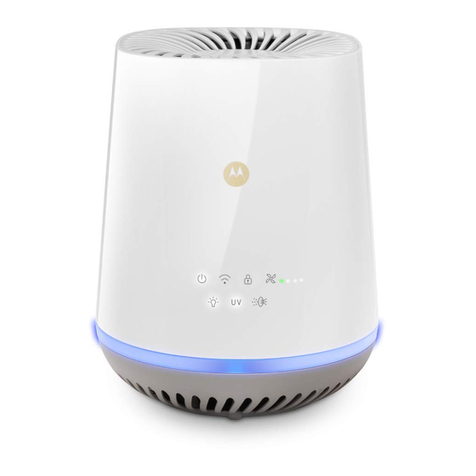
2
Please read instructions before installing and using the Elec-
tronic Air Cleaner. This will help you obtain the full benefit from
the Electronic Air Cleaner you have selected.
SSC1000 Self Contained Drop In Electronic Air CleanerSSC1000 Self Contained Drop In Electronic Air Cleaner
SSC1000 Self Contained Drop In Electronic Air CleanerSSC1000 Self Contained Drop In Electronic Air Cleaner
SSC1000 Self Contained Drop In Electronic Air Cleaner
ModelModel
ModelModel
Model: SSC1000
VoltageVoltage
VoltageVoltage
Voltage: 120 VAC, 60 Hz.
Amps HI-speedAmps HI-speed
Amps HI-speedAmps HI-speed
Amps HI-speed: 2.5 A.
Watts HI-speedWatts HI-speed
Watts HI-speedWatts HI-speed
Watts HI-speed: 240
WeightWeight
WeightWeight
Weight: 50 lbs.
Shipping WeightShipping Weight
Shipping WeightShipping Weight
Shipping Weight: 58 lbs.
▲
!WW
WW
WARNINGARNING
ARNINGARNING
ARNING
Do not attempt installation of this unit unless you areDo not attempt installation of this unit unless you are
Do not attempt installation of this unit unless you areDo not attempt installation of this unit unless you are
Do not attempt installation of this unit unless you are
familiar with the necessary tools, equipment, utilityfamiliar with the necessary tools, equipment, utility
familiar with the necessary tools, equipment, utilityfamiliar with the necessary tools, equipment, utility
familiar with the necessary tools, equipment, utility
connections and potential hazards.connections and potential hazards.
connections and potential hazards.connections and potential hazards.
connections and potential hazards.
Installation should be performed only by a qualifiedInstallation should be performed only by a qualified
Installation should be performed only by a qualifiedInstallation should be performed only by a qualified
Installation should be performed only by a qualified
service provider.service provider.
service provider.service provider.
service provider.
Failure to do so could result in reduced performanceFailure to do so could result in reduced performance
Failure to do so could result in reduced performanceFailure to do so could result in reduced performance
Failure to do so could result in reduced performance
of the unit, serious personal injury or death.of the unit, serious personal injury or death.
of the unit, serious personal injury or death.of the unit, serious personal injury or death.
of the unit, serious personal injury or death.
▲
!WW
WW
WARNINGARNING
ARNINGARNING
ARNING
Installation of this unit must comply with local electricInstallation of this unit must comply with local electric
Installation of this unit must comply with local electricInstallation of this unit must comply with local electric
Installation of this unit must comply with local electric
codes or other applicable codes.codes or other applicable codes.
codes or other applicable codes.codes or other applicable codes.
codes or other applicable codes.
Review and understand local codes prior toReview and understand local codes prior to
Review and understand local codes prior toReview and understand local codes prior to
Review and understand local codes prior to
installation.installation.
installation.installation.
installation.
Do not use this apparatusDo not use this apparatus
Do not use this apparatusDo not use this apparatus
Do not use this apparatus in an explosive atmosphere.in an explosive atmosphere.
in an explosive atmosphere.in an explosive atmosphere.
in an explosive atmosphere.
Failure to do so could result in serious personal injuryFailure to do so could result in serious personal injury
Failure to do so could result in serious personal injuryFailure to do so could result in serious personal injury
Failure to do so could result in serious personal injury
or death.or death.
or death.or death.
or death.
1. Read the Owners Manual and the Rules for Safe
Operation carefully. Failure to follow these rules and
instructions could cause a malfunction of filter or
unsatisfactory service.
2. Follow a regular service and maintenance schedule
for efficient operation.
Fan SpeedFan Speed
Fan SpeedFan Speed
Fan Speed: Variable 200 to 1000 CFM
DimensionsDimensions
DimensionsDimensions
Dimensions: 233/4”H x 233/4”W x 113/4”D
EfficiencyEfficiency
EfficiencyEfficiency
Efficiency: Efficiency varies with fan speed approximately 90%
at low speed and 65% at hi speed.
Installation EfficiencyInstallation Efficiency
Installation EfficiencyInstallation Efficiency
Installation Efficiency
NOTENOTE
NOTENOTE
NOTE:Unit must run for one full hour after installation.
This will allow the collecting cells to reach
peak efficiency.
SpecificationsSpecifications
SpecificationsSpecifications
Specifications
Table of ContentsTable of Contents
Table of ContentsTable of Contents
Table of Contents
Basic Tools RequiredBasic Tools Required
Basic Tools RequiredBasic Tools Required
Basic Tools Required
Basic Tools Required . . . . . . . . . . . . . . . . . . 2
Specifications . . . . . . . . . . . . . . . . . . . . . . . . 2
How the Air Cleaner Works . . . . . . . . . . . . 2,3
Rules for Safe Installation and Operation . . 3
Installation . . . . . . . . . . . . . . . . . . . . . . . . . . 3
Operation & Maintenance . . . . . . . . . . . . . . 4
Troubleshooting Guide. . . . . . . . . . . . . . . . . 5
Replacement Parts Listing . . . . . . . . . . . . . . 7
Electronic Air Cleaner Wash Reminder . . . . 8
Screwdriver, Rule or Tape Measure, Drill
HOHO
HOHO
HOWW
WW
W THETHE
THETHE
THE AIR CLEANERAIR CLEANER
AIR CLEANERAIR CLEANER
AIR CLEANER WW
WW
WORKSORKS
ORKSORKS
ORKS
The enclosed fan circulates the air up through the bottom of the
electronic air cleaner and out through the four outlet grilles. The
ionizing section of the collecting cell contains many fine ionizing
wires that charge the incoming airborne particles. The charged
particles move into the collecting plate area and are trapped to the
plates (like a magnet attracts and collects iron filings).
The cleaned air is then drawn through a charcoal filter to assist in
removal of unpleasant odors. The cleaned and purified air is
discharged to recirculate through your building.
White Dust (Lint)White Dust (Lint)
White Dust (Lint)White Dust (Lint)
White Dust (Lint)
An Electronic Air Cleaner is designed to collect two major types of
contaminants: ➀ Irritants (Pollens, Spores, Molds, Bacteria, etc.)
and ➁Black Soiling Contaminants (Dirt and Smoke particles).
The residue on the collecting plates of an electronic air cleaner is
black, indicating it is removing dirt from the air stream. After
installing an air cleaner you may notice white dust (typically, long
linty particles or fibers – from carpets, cotton materials or drapery
fabrics). This material is not collected by the air cleaner because it
does not contain the irritants or soiling contaminants listed above or
settles out of the air before reaching the air cleaner. The presence of
white dust does not indicate an air cleaner requires service.
Carbon (Charcoal) FiltersCarbon (Charcoal) Filters
Carbon (Charcoal) FiltersCarbon (Charcoal) Filters
Carbon (Charcoal) Filters
Odors are gas molecules, not particles. They cannot be removed by
an Electronic Air Cleaner or by any other filtration media designed to
remove airborne particles. However, some gases can be absorbed
by an activated carbon filter or diluted with fresh outdoor air. When
odors are present, the addition of charcoal filters will neutralize
odors, such as cooking odors, pet odors, cigar and cigarette odors,
ozone, etc. Optional charcoal filters are available for your Air
Cleaner. Refer to the parts list for the charcoal filter part number for
your Air Cleaner. Charcoal filters require replacement. They cannot
be washed. While there is no rule of thumb for how often they should
be changed, you can use your best judgement based on the odors
you perceive in your environment.
Shut off power at fuse panel beforeShut off power at fuse panel before
Shut off power at fuse panel beforeShut off power at fuse panel before
Shut off power at fuse panel before
servicing. Failure to do so could resultservicing. Failure to do so could result
servicing. Failure to do so could resultservicing. Failure to do so could result
servicing. Failure to do so could result
in serious personal injury or death.in serious personal injury or death.
in serious personal injury or death.in serious personal injury or death.
in serious personal injury or death.
ELECTROCUTION HAZARDELECTROCUTION HAZARD
ELECTROCUTION HAZARDELECTROCUTION HAZARD
ELECTROCUTION HAZARD
▲
!WW
WW
WARNINGARNING
ARNINGARNING
ARNING
▲
!CACA
CACA
CAUTIONUTION
UTIONUTION
UTION
CABINET AND CELLS MAY CONTAINCABINET AND CELLS MAY CONTAIN
CABINET AND CELLS MAY CONTAINCABINET AND CELLS MAY CONTAIN
CABINET AND CELLS MAY CONTAIN
SHARP EDGES.SHARP EDGES.
SHARP EDGES.SHARP EDGES.
SHARP EDGES.
Use care when servicing unit or handl-Use care when servicing unit or handl-
Use care when servicing unit or handl-Use care when servicing unit or handl-
Use care when servicing unit or handl-
ing cells. Failure to do so could result ining cells. Failure to do so could result in
ing cells. Failure to do so could result ining cells. Failure to do so could result in
ing cells. Failure to do so could result in
minor personal injury.minor personal injury.
minor personal injury.minor personal injury.
minor personal injury.

